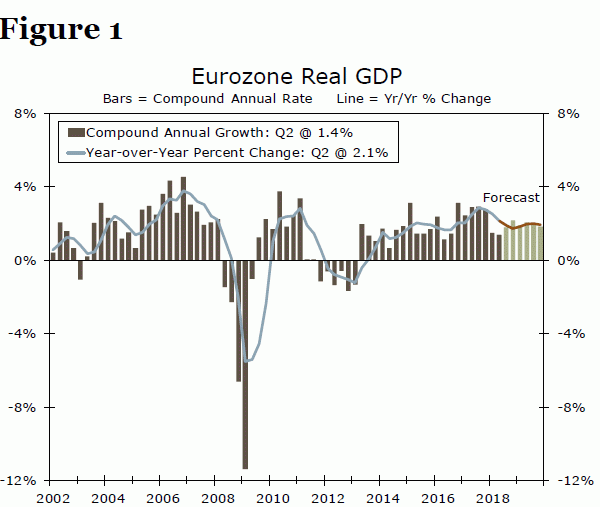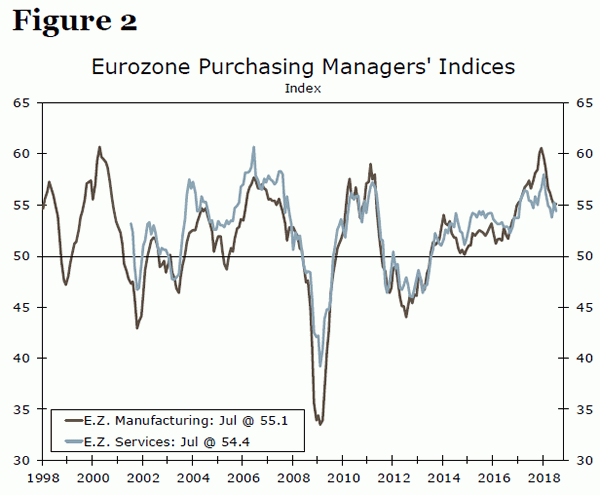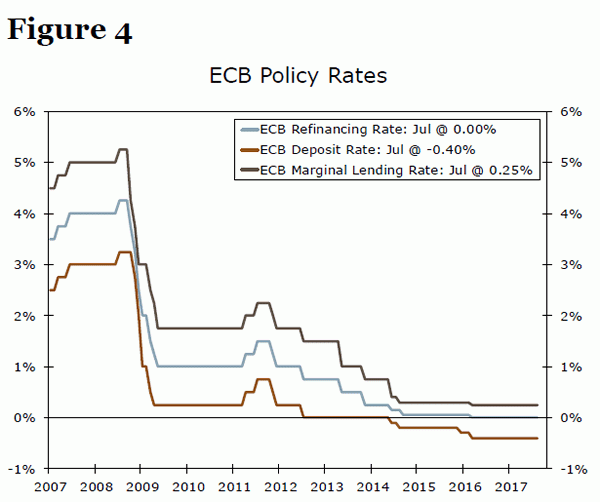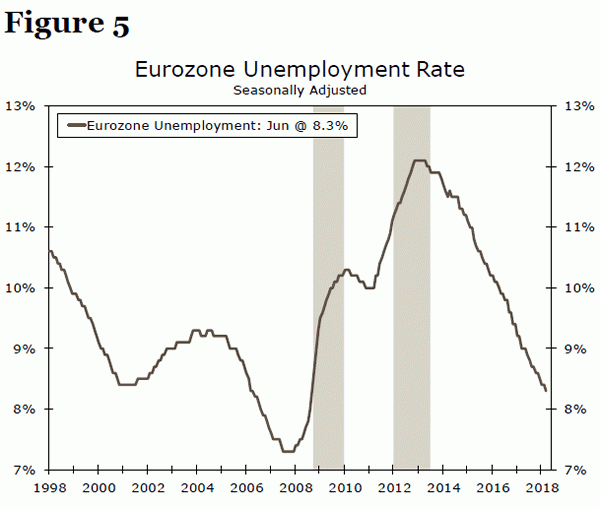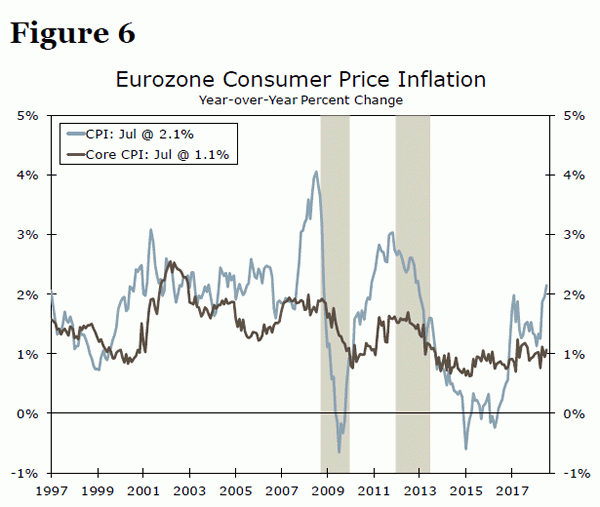Executive Summary
Real GDP growth in the Eurozone slowed modestly in Q2, at 2.1 percent year over year. That said, the manufacturing sector and consumer spending were likely bright spots, and a tight labor market along with slowly rising incomes should support economic growth in the coming quarters. While GDP growth has remained solid, inflation in the Eurozone is still largely benign. Although headline inflation has picked up to reach the ECB’s 2 percent target in recent months, core inflation still remains steady around 1 percent and has restrained the more rapid removal of policy accommodation on the part of the ECB. That said, the Governing Council has stated it plans to end its QE program at the end of this year. Assuming economic growth and inflation continue to pick up, we then look for the Governing Council to begin raising rates in early autumn 2019.
Amid the backdrop of solid economic growth and accommodative monetary policy, trade tensions in the Eurozone heated up in Q2 as the Trump administration threatened a 25 percent tariff on auto imports from the European Union (EU). A recent Washington, D.C. summit between President Trump and European Commission President Juncker has since calmed the nerves of trade watchers as the two countries agreed to work toward removing trade barriers. However, the situation could deteriorate again if negotiations were to reach an impasse. In our view, a fullblown trade war, should one come to pass, probably would not completely derail the Eurozone economy. Exports to the United States totaled just 2.5 percent of Eurozone GDP in 2017, meaning that the effect from tariffs could be painful, but not large enough to meaningfully drag on the overall economy. Although trade tensions present a downside risk to our forecast, we look for the economic expansion to remain in place, and forecast that real GDP will grow roughly 2 percent this year and in 2019.
Eurozone GDP Decelerates Further in Q2
Data released today showed that real GDP in the Eurozone rose 0.3 percent (1.4 percent at an annualized rate) in Q2-2018 relative to the previous quarter, which was a bit lower than the consensus forecast (Figure 1). On a year-ago basis, GDP was up 2.1 percent, which is not as strong as the 2.7 percent rate that was registered at the end of last year. Looking forward, we forecast that the year-over-year rate of GDP growth will slow further, although we believe that the expansion in the euro area that has been in place for the past five years will remain intact.
A breakdown of the real GDP data into its underlying demand components will not be available until next month. While it is too early to pinpoint the exact cause of the Q2 deceleration, monthly economic indicators still point to the solid nature of the underlying expansion. The Q1 slowdown was due in part to lackluster manufacturing output as the region experienced colder-than-normal temperatures, but the manufacturing sector looks to be recovering so far in Q2. Industrial production rose 1.3 percent in May after dropping into negative territory in April. Although the purchasing managers’ indices (PMI) have trended lower so far this year, they still remain above the 50 demarcation line that signals expansion, with the manufacturing PMI rising 0.2 points to 55.1 in July’s preliminary reading (Figure 2).
Alongside solid manufacturing output, consumer spending also looks to have remained firm in Q2 after rising a solid 0.5 percent in Q1. Although retail sales only make up a portion of total consumer spending, real retail sales rose 0.6 percent through the first two months of the quarter relative to Q1. As we discuss in more detail below, the labor market remains tight, and with inflation still relatively benign, the gradual pick up in real wages along with the solid pace of job gains should support growth in consumer spending in the coming quarters.
Although trade tensions have cooled in recent weeks, international trade in the Eurozone likely moderated slightly in Q2, as real exports dropped 0.2 percent through the first two months of Q2 relative to Q1. That said, solid global demand should support a rebound in exports in the coming quarters. On net, the monthly indicators paint a slightly more upbeat picture of the underlying trends in the Eurozone economy, and economic growth should continue in the coming quarters.
ECB Policy to Remain Accommodative for the Foreseeable Future
As noted above and as shown in Figure 1, we forecast that the economic expansion in the Eurozone will remain intact through the end of 2019. As we discuss in more detail subsequently, monetary policy in the euro area remains accommodative, which should help support growth in consumption and investment expenditures. Fiscal policy is no longer exerting strong headwinds on GDP growth as it was a few years ago when austerity held sway at the height of the European sovereign debt crisis. Growth in exports should remain buoyant due to solid economic growth in most of the Eurozone’s major trading partners. That said, a potential trade war with the United States, which we also discuss in more detail subsequently, represents a downside risk to our real GDP forecast for the euro area.
Although a self-sustaining economic expansion has been underway for some time in the Eurozone, the European Central Bank (ECB) has not yet started the process of removing its extraordinary degree of policy accommodation. Indeed, the ECB continues to maintain its quantitative easing (QE) program (Figure 3), although the Governing Council has said that it will cease buying bonds altogether at the end of the year. In addition, the Governing Council has not made any moves yet to raise the ECB’s three policy rates from their historic lows (Figure 4).
The economic expansion, which has been underway in the euro area for the past five years, has led to a marked decline in the unemployment rate over that period (Figure 5). Although the unemployment rate has not yet reached the low that was set at the end of the last expansion, it is only 1 percentage point from that nadir. Despite solid economic growth and the noticeable improvement in the labor market, the ECB has yet to remove policy accommodation. Why is the Governing Council dragging its feet?
The ECB has a single mandate, namely price stability, which it interprets as “inflation rates below, but close to, 2 percent over the medium term.” As shown in Figure 6, the overall CPI inflation rate is currently 2.1 percent. However, the core rate of inflation, which excludes prices of food, energy, alcohol and tobacco, has been steady at roughly 1 percent over the past three years. Because prices of the goods that are excluded from the core CPI tend to be volatile, the core rate of CPI inflation is a good measure of the underlying inflationary pressures in the economy. In short, the ECB has refrained from removing policy accommodation because there are few inflationary pressures in the Eurozone at present.
We take the Governing Council at its word when it says that it intends to wrap up its QE program at the end of the year.1 The Governing Council has also said that it intends to keep its three policy rates unchanged at their current levels “at least through the summer of 2019.” If our forecast of continued economic expansion and gradually rising core inflation in the Eurozone comes to pass, then we would expect that the Governing Council will raise the deposit rate from -0.40 percent to -0.20 percent in early autumn 2019. But we expect that the Governing Council will leave the ECB’s main refinancing rate, currently 0.00 percent, and the rate on the marginal lending facility (0.25 percent) unchanged initially. At the end of 2019, we forecast that the Governing Council will raise the ECB’s deposit rate to 0.00 percent, the main refinancing rate to 0.25 percent and the rate on the marginal lending facility to 0.50 percent.
Could a Trade War Derail the Economic Expansion in the Euro Area?
The airwaves have been filled this year with threats of potential trade wars. Not only has the ire of the Trump administration been directed at China, but the EU has also felt its wrath. For starters, the administration has levied a 25 percent tariff on imports of steel products and a 10 percent tariff on imports of aluminum products from many of America’s trading partners, including the countries of the EU. In addition, the administration has threatened to levy a 25 percent tariff on auto imports from the EU. The EU responded with its own retaliatory tariffs on some American-made goods.
Trade tensions between the United States and the EU ratcheted down a notch at a meeting in Washington, D.C. on July 25 between Jean-Claude Juncker, president of the European Commission, and President Trump. The two leaders agreed to work toward the elimination of all trade barriers between the two economies, and Juncker promised that the EU would buy more American soybeans and liquid natural gas (LNG). In return, Trump agreed that the United States would not raise tariffs on European autos, at least not for the time being. A trade war has been averted for now, but tensions could easily return if negotiations bog down. Could a trade war, should one eventually occur, bring the Eurozone economy to its knees?
Last year, the United States imported $6 billion worth of steel products from the EU and an additional $1.3 billion of aluminum products. EU exports of steel and aluminum products to the United States likely will be lower this year than they were in 2017 due to the tariffs that have been imposed. American imports of autos and auto parts from the EU were an order of magnitude larger, totaling about $50 billion in 2017. EU exports of autos and auto parts could weaken significantly going forward if the threatened tariffs actually were to be imposed.
Although individual European producers of steel, aluminum and autos could be harmed significantly by American trade restrictions, the tariffs are not likely to have a meaningful effect on the macro Eurozone economy. Last year, nominal GDP in the euro area totaled more than €11 trillion (nearly $15 trillion at the PPP exchange rate). Declines in steel, aluminum and auto exports are simply not large enough to cause a significant weakening in the Eurozone economy.
A full-blown trade war, in which the United State levied tariffs on all of its imports from the Eurozone, would be more painful, but it probably would not be a complete catastrophe either. The United States imported $330 billion worth of goods from euro area countries in 2017. This amount was equivalent to 2.5 percent of Eurozone GDP, but exports would not collapse completely, even if tariffs were levied on all goods. We do not have a well-informed view of the ultimate outcome of the current trade tensions/negotiations between the United States and the EU. If a full-blown trade war actually were to come to pass, we would need to ratchet back our growth outlook for the Eurozone in coming quarters. But we probably would not forecast an outright recession simply because Eurozone exports to the United States likely would not weaken enough to produce an outright recession.
Conclusion
Although real GDP growth in the Eurozone decelerated slightly in Q2, the underlying nature of the economic expansion remains intact. Firming manufacturing output and solid consumer spending should continue to support economic growth in the coming quarters. Lackluster price pressures have also led the ECB to keep monetary policy firmly in accommodative territory, although the Governing Council has signaled that it intends to end its QE program at the end of 2018. We take the Governing Council at its word, and assuming our expectations of economic growth and slowly rising inflation play out, we then look for the ECB to begin to slowly raise rates in the early autumn of 2019. While trade tensions pose a downside risk to our outlook, we do not view recent trade disputes as having a meaningful effect on the current economic expansion. We look for Eurozone real GDP to grow roughly 2 percent this year and in 2019.
1 The Governing Council announced on June 14 that it would reduce its monthly purchase rate from €30 billion to €15 billion after September 2018 and that it would cease buying bonds altogether after December.




